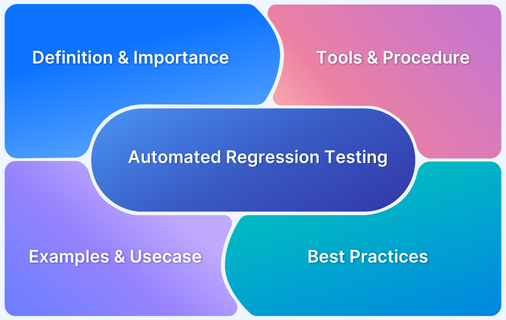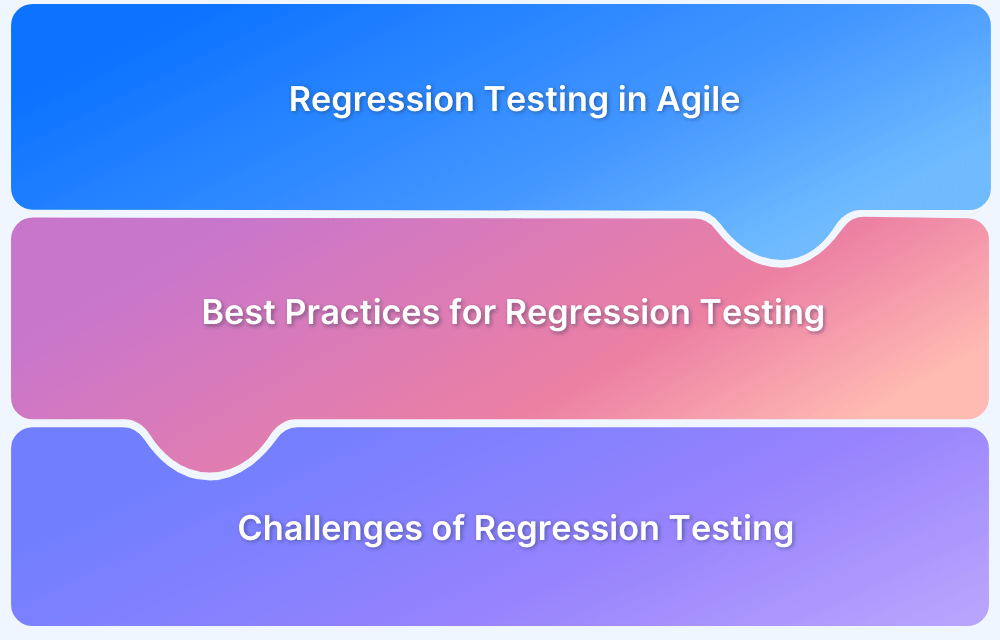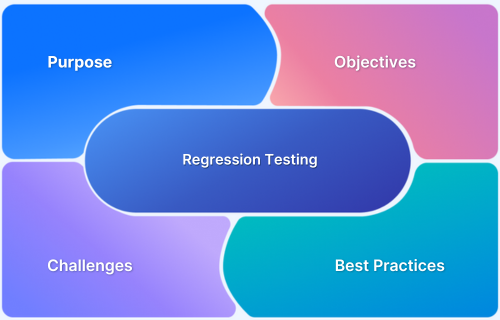Is your regression testing strategy keeping up with the rapid pace of development? As new code changes are frequently introduced, ensuring they don’t disrupt existing functionality becomes increasingly critical to maintaining software quality.
This challenge is evident to many teams; according to a recent study by Simform, 50.5% of organizations prioritize automating regression tests, recognizing its key role in maintaining software stability and speed.
Yet, despite this awareness, the reality is challenging. As software complexity grows and release frequencies accelerate, managing regression testing effectively becomes harder.
To overcome this obstacle, a successful regression testing strategy must prioritize tests intelligently, optimize automation workflows, and ensure tests are both effective and efficient.
This article explores strategies to optimize regression testing and streamline test maintenance for long-term quality assurance success.
What is Regression Testing?
Regression testing is a type of software testing focused on verifying that new code changes—such as enhancements, patches, or bug fixes—do not negatively impact existing functionality. Unlike unit or functional testing, which targets specific modules, regression testing covers the entire system to confirm that stable features continue to work as intended.
This process often includes re-running previously executed test cases, along with updated ones, to ensure software stability across different builds.
Regression testing can be manual or automated, but given the repetitive nature of these checks, automation is widely adopted. Automated regression suites integrated with CI/CD pipelines help teams detect issues quickly and provide faster feedback, which is essential for modern agile and DevOps workflows.
Why is Performing Regression Testing Important?
Performing regression testing is crucial because even minor code changes can have unintended side effects that break previously stable features. Without systematic regression validation, defects introduced during updates may only surface in production, leading to costly rollbacks, downtime, or reputational damage.
Key reasons regression testing is important include:
- Preserving product stability: It ensures that core workflows remain functional after modifications, updates, or third-party integrations.
- Supporting continuous delivery: Automated regression runs allow teams to deploy frequently while maintaining confidence in software quality.
- Reducing business risk: Early detection of regressions prevents expensive hotfixes and customer dissatisfaction.
- Improving developer productivity: Clear regression results help developers pinpoint issues quickly, minimizing time spent on root cause analysis.
Why is Regression Testing Part of Test Maintenance?
Test maintenance involves keeping the entire test suite relevant, efficient, and aligned with current application behavior. Regression testing naturally forms a large part of this process because regression suites grow with every new feature, bug fix, or refactor. If not actively maintained, they become bloated, outdated, or unreliable.
- Keeping test cases current: As features evolve, regression tests need constant updates to remain accurate. Test maintenance ensures coverage matches the product’s present state.
- Eliminating redundancy: Old or duplicated regression tests can waste execution time. Maintenance activities remove such inefficiencies.
- Managing test debt: Unmaintained regression tests lead to “test debt,” where growing instability and outdated cases slow down the feedback loop. Maintenance helps prevent this accumulation.
- Maintaining CI/CD efficiency: A regression suite that is not actively maintained can introduce flakiness and unnecessary failures, undermining confidence in automation pipelines.
In essence, regression testing is not a standalone activity but a continuous part of test maintenance. It keeps the test suite effective, scalable, and aligned with the product’s evolution.
How can you Manage Time-Consuming Regression Tests?
Large regression test suites can slow down delivery pipelines. Optimizing these tests is essential for maintaining agility.
- Test suite minimization: Regularly analyze the suite to identify and remove redundant, outdated, or low-value tests. This ensures that only meaningful test cases are executed, reducing cycle time.
- Parallel test execution: Leverage test infrastructure that supports parallelization, distributing test cases across multiple machines or environments. This drastically reduces overall execution time and provides quicker feedback.
- Risk-based prioritization: Not all tests need to be run equally. Prioritize high-risk areas or business-critical functionality, ensuring the most important features are validated first when time is constrained.
- Automation of repetitive tests: Repeated manual execution consumes resources. Automating these tests accelerates regression cycles and frees testers for exploratory and edge-case validations.
Regression tests can be time-consuming and impact the overall efficiency of your testing process, potentially delaying releases and increasing costs. Our experts can help you create an effective automation strategy that not only speeds up your regression testing but also improves accuracy and ensures comprehensive test coverage across your application.
Get Expert QA Guidance Today
Schedule a call with BrowserStack QA specialists to discuss your testing challenges, automation strategies, and tool integrations. Gain actionable insights tailored to your projects and ensure faster, more reliable software delivery.
Why and how do you maintain a Growing Test Suite?
As features expand, maintaining a growing test suite prevents inefficiencies and irrelevance.
- Regular auditing: Periodically review the test suite to identify cases that are obsolete due to deprecated features or updated functionality. Auditing ensures the suite evolves with the application.
- Modular design: Write test cases in reusable, modular components. This approach enables quick updates across multiple tests when shared functionalities change, saving time and reducing duplication.
- Continuous refactoring: Improve existing tests for readability, stability, and performance. Well-structured tests are easier to maintain and scale with product growth.
- Documentation updates: Maintain updated documentation of test cases and their purpose. Proper documentation helps testers understand dependencies and prevents incorrect modifications.
How can you Address Flaky Tests in CI/CD Pipelines?
Flaky tests in CI/CD pipelines undermine trust in automation, as they produce inconsistent results.
- Root cause analysis: Investigate failures to determine whether flakiness is caused by unstable test code, asynchronous operations, environment inconsistencies, or unreliable data.
- Isolation of test environments: Use containerized or sandboxed environments to eliminate cross-test interference and minimize dependency-related issues.
- Retry mechanisms with caution: Introduce retries for tests with known instability to reduce false negatives, but ensure underlying causes are eventually fixed.
- Clear logging: Enhance test logs with detailed failure reports. Rich logs provide actionable insights for quicker debugging and resolution.
How do you Keep Tests Updated with New Features?
Keeping tests updated with new features ensures coverage remains accurate and comprehensive.
- Shift-left testing: Engage QA during requirement and design stages, enabling early preparation of test cases for upcoming features.
- Update regression suites with every release: Incorporate new features into regression suites immediately after development, preventing coverage gaps from widening.
- Cross-functional reviews: Involve developers and QA in reviewing test coverage for new features, ensuring alignment with intended functionality.
- Automation-first approach: Automate new test scenarios wherever feasible. This maintains testing velocity and ensures new features are consistently validated.
How can you Handle Test Debt Accumulation?
Test debt occurs when tests are postponed, neglected, or left outdated. Handling test debt accumulation requires proactive measures.
- Scheduled maintenance cycles: Allocate time within sprints specifically for cleaning and maintaining test cases. This prevents long-term buildup of unusable tests.
- Track debt metrics: Monitor the number of skipped, outdated, or broken tests to quantify test debt and highlight urgent areas needing attention.
- Refactor continuously: Encourage ongoing refinement of test cases rather than deferring it, reducing the likelihood of debt accumulation.
- Integrate into backlog: Treat test debt like technical debt, prioritizing it in the backlog so that it receives adequate focus during sprint planning.
How do you Prioritize Tests During Sprints?
Managing test prioritization in sprints ensures coverage without delaying delivery.
- Risk-based prioritization: Focus execution on the most business-critical or failure-prone modules, ensuring essential features are validated first.
- Regression buckets: Divide test cases into tiers such as critical, high, and low. Execute critical tests during every sprint, while deferring lower-priority tests for later cycles.
- Align with sprint goals: Only prioritize tests directly related to features developed or modified during the sprint, avoiding unnecessary regression overhead.
- Automate smoke tests: Automating smoke and sanity tests ensures immediate validation of core functionality at the start of each sprint cycle.
Read More: Regression Testing in Agile: Getting Started
How can you Foster Collaboration Between QA and Developers?
Ensuring collaboration between QA & devs improves test quality and reduces bottlenecks.
- Shared responsibility: Embed QA engineers within development teams to promote joint ownership of product quality. This reduces “handoff” delays.
- Communication channels: Use daily stand-ups and sprint grooming to ensure QA is involved in planning, execution, and retrospective discussions.
- Pair testing: Encourage developers and testers to collaborate during exploratory and acceptance testing sessions for faster defect identification.
- Shared tooling: Utilize unified platforms that provide visibility to both QA and developers, creating a single source of truth for test progress.
Read More: Top 15 Python Testing Frameworks
How do you avoid Test Case Duplication and Redundancy?
Duplication wastes resources and increases maintenance overhead. Avoiding redundancy ensures lean, effective test suites.
- Centralized test repository: Store test cases in a single, version-controlled repository to improve traceability and visibility.
- Standard naming conventions: Adopt consistent naming schemes for test cases, making them easier to search and reuse.
- Review processes: Implement mandatory peer reviews for new test cases to prevent overlaps with existing ones.
- Automation coverage reports: Use reporting tools to highlight overlapping or redundant automated test cases. This enables pruning of unnecessary scenarios.
How can you Standardize Test Processes Across Teams?
Lack of standardized test processes leads to inconsistency and inefficiency across teams.
- Common test frameworks: Encourage all teams to adopt a unified test framework, ensuring consistency across the organization.
- Clear guidelines: Document and enforce best practices for writing, executing, and maintaining tests. Standardization reduces confusion and training overhead.
- Shared KPIs: Track metrics like defect leakage, execution times, and flakiness rates across all teams to create a uniform measure of success.
- Training and workshops: Conduct workshops to keep all teams aligned with standard practices and tool usage.
Read More: What to Include in a Regression Test Plan?
What are the Best Practices for Efficient Regression Testing and Test Maintenance?
Several best practices ensure regression testing and maintenance remain efficient and sustainable.
- Balance manual vs. automated testing: Use automation for repetitive and stable scenarios, while reserving manual testing for exploratory or user-centric workflows.
- Incremental execution: Instead of running the entire suite every time, run targeted subsets relevant to the latest changes.
- Continuous monitoring: Regularly measure the effectiveness of regression tests to identify gaps or areas needing optimization.
- Early involvement: Ensure QA participates in design discussions, enabling proactive planning for regression coverage.
- Tool integration: Integrate testing seamlessly into CI/CD pipelines and use dashboards for transparent reporting and tracking.
- Maintain a Modular Test Suite: Keep tests modular to facilitate easier maintenance and reduce redundancy, allowing quick updates as the application evolves.
- Use Risk-Based Prioritization: Prioritize high-risk or business-critical functionalities to ensure that key features are always validated during regression tests.
- Regular Test Suite Audits: Periodically review and update the test suite to eliminate obsolete tests and ensure it is aligned with the current product.
- Optimize Test Environments: Ensure consistent test environments to minimize flaky tests and achieve stable results across different platforms and configurations.
- Avoid Test Debt: Continuously refactor outdated tests and allocate time in the sprint for test maintenance to prevent test debt from accumulating.
Why choose BrowserStack for Regression Testing?
Regression testing at scale requires both functional validation and visual accuracy across browsers and devices. BrowserStack offers a comprehensive solution through BrowserStack Automate for automated functional regression testing and Percy for visual regression testing, helping teams ensure reliability, speed, and UI consistency in every release.
BrowserStack Automate: Functional Regression Testing
BrowserStack Automate enables teams to run automated regression suites on real browsers and devices without managing on-premise infrastructure. It is designed to accelerate feedback loops while ensuring tests are executed in production-like conditions.
Key features of BrowserStack Automate:
- 3,500+ real browsers and devices: Test across a wide range of operating systems and browsers to ensure compatibility for all users.
- Parallel test execution: Run multiple tests simultaneously to reduce cycle times for large regression suites.
- Seamless CI/CD integration: Plug into popular CI/CD tools such as Jenkins, GitHub Actions, CircleCI, and more for continuous testing.
- Reliable infrastructure: Cloud-hosted, secure environments eliminate flakiness caused by local setup or emulator limitations.
- Debugging at scale: Access detailed logs, video recordings, and network capture to quickly identify regression failures.
Percy by BrowserStack: Visual Regression Testing
While functional regression testing ensures features work as expected, visual regressions often go unnoticed. Percy automates UI validation by comparing visual snapshots across builds, highlighting even pixel-level changes.
Key features of Percy:
- Automated visual diffs: Capture UI changes across browsers, viewports, and responsive layouts with snapshot comparisons.
- Cross-browser visual validation: Test visual consistency across Chrome, Firefox, Safari, and Edge simultaneously.
- CI/CD workflow integration: Trigger visual regression tests on every pull request or deployment to catch issues early.
- Team collaboration: Share snapshot diffs with developers, designers, and QA for quick review and approval.
- Reduced manual effort: Replace labor-intensive visual checks with automated, scalable workflows.
Conclusion
Regression testing and test maintenance are critical for software quality and delivery speed. From addressing test debt accumulation and flaky pipelines to avoiding redundancy and keeping tests updated with new features, efficient practices drive better outcomes.
With the right strategies, QA teams can balance manual vs. automated testing, streamline test prioritization in sprints, and establish standardized processes across teams. Leveraging platforms like BrowserStack Automate ensures regression testing not only scales with software complexity but also delivers reliability and speed consistently.






